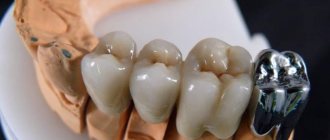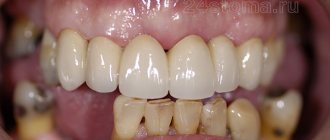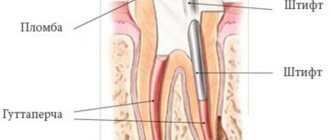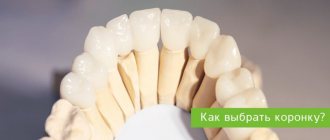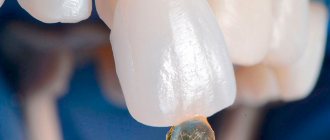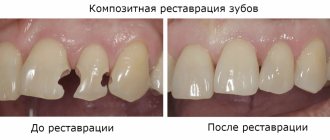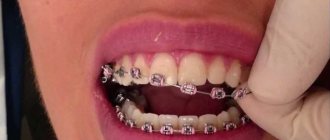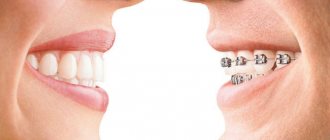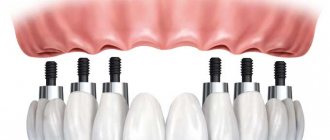What is the difference between a crown and a veneer?
Experts classify both crowns and veneers as orthopedic dentistry, which deals with dental prosthetics. If we talk about the purpose, then in the conventional orthopedic chain “crown-inlay-veneer” the last product is primarily intended to create aesthetics, while crowns and inlays are needed to primarily restore the functionality of the tooth. In dentistry, a separate category is allocated for veneers - microprosthetics, which well reflects the most important visual difference between veneers and crowns. A crown completely copies the entire visible part of a tooth, while veneers model only its outer (vestibular) side.
What veneers and crowns have in common is the fact that both are made in a dental laboratory, but this does not apply to direct composite onlays. In their case, the need for a laboratory stage is eliminated: the application of the composite material is carried out directly in the patient’s mouth, so the procedure does not require taking impressions and is considered an artistic restoration. As for manufacturing materials, there is great variability in crowns. Both designs can be produced from ceramics and zirconium dioxide. However, zirconium veneers are rarely used: zirconium does not adhere well to the teeth, requires significant grinding and looks unnatural.
How are they different, help in choosing
Although both types of restoration visually create the same end result, they are very different in application. The most significant difference between veneers and crowns is the depth of treatment of enamel and dentin, because they are installed in different ways:
- crowns cover the entire tooth;
- veneers cover only the outer side (the one that is visible when a person smiles).
The tooth prepared for the prosthesis is greatly reduced in size and ground to a conical shape. The amount of reduction required is at least 2 mm (depending on the degree of damage). It is based on the fact that the standard crown wall thickness is 2 mm. However, this also depends on the type of materials. For example, metal ones are usually somewhat thinner.
When it comes to the benefits of veneers or ceramics, it is better to proceed from the facts, because they have an individual set of characteristics that are taken into account for the best choice. Pros and cons of crowns:
- Requires deep grinding.
- Due to the metal base they look less natural.
- Can be used to change color and shape more significantly.
- Used to restore and strengthen severely damaged teeth.
- Very strong, durable and the best choice for heavy chewing loads.
Crowns are used for large-scale restoration of severely damaged teeth. Veneers are usually used when minimal cosmetic interventions are required.
For example, they are used in the following cases:
- Used to change color (slight to moderate usually gives the most realistic results).
- You can slightly adjust the shape.
- Placed on healthy and undamaged teeth.
- Porcelain veneers most closely mimic natural teeth, but they are too fragile. They are usually installed in areas with relatively light and passive loads.
- Less traumatic, as they require little trimming; in some cases, they are installed without it.
- Once treated, a tooth will always need some type of coating.
Modern restoration materials meet the highest demands of beauty and functionality, although they have different structural characteristics. It is better to entrust the final decision in choosing between veneers or metal-ceramics to an experienced dentist, because the secret of an excellent result lies in his skillful hands, and an indicator of the perfection of technology is the natural and healthy appearance of teeth.
What is better - veneers or crowns?
Talking about which is better (veneers or crowns) is like comparing a car and a motorcycle. Each of these methods has its own advantages and indications for use. Below is a table that shows situations when it is most preferable to use crowns and when to use veneers.
| Indications for installation of veneers | Indications for crown installation |
|
|
By and large, crowns and veneers have different indications for installation, however, there are situations in which the patient can choose between two products.
Drawing up a treatment plan at Dial-Dent
During a consultation with a dentist, an examination was carried out and a panoramic photograph of the teeth was taken.
Problems that the orthopedic dentist saw:
- Old (installed more than 10 years ago) metal-ceramic bridges in the lateral areas of the upper and lower jaws. Some crowns are chipped, the gums under the dentures are inflamed, the patient complains of food getting under the denture and frequent inflammation and swelling of the gums.
- There is no distant tooth on the upper jaw; no prosthetics were performed.
- Severe accumulation of tartar on the inner surface of the lower front teeth, bleeding gums.
- There is a gap between the upper front teeth, and also gaps between the lower front teeth. The color of the front teeth is very different from the color of metal-ceramic dentures. The front teeth are dark, which makes the patient look older.
- The patient strongly clenches her teeth, which is why cracks appeared on the upper teeth, the front teeth were severely worn, and the plane of closure of the teeth was disrupted.
- Insufficient bite height due to worn teeth. The bite affects the shape of the lips and the folds around the mouth. So, in this case, the folds in the corners of the mouth are strengthened, and the chin fold is strongly pronounced.
- When the mouth is partially opened, the upper front teeth are not visible, which makes the face look older.
The panoramic image shows the problems that dentists need to solve:
- If you have no teeth, you need to install implants to restore missing teeth.
- Small bone height - a short implant will be required.
- A cyst around the root of a tooth - it is necessary to carry out an inspection with a microscope, based on the results of which a decision can be made whether to treat this tooth or remove it.
- The canals in the teeth have been treated unsatisfactorily; it is necessary to re-treat the canals of the teeth under a microscope to ensure guaranteed health of the teeth under the crowns.
At the Family Dental Clinic, when planning complex dental treatment, the patient undergoes all the necessary studies - a panoramic photograph of the teeth, computed tomography, photographing the teeth and face from different angles, taking impressions of the teeth, and also provides consultations with all the necessary specialists.
In this case, the patient was advised:
- orthopedic dentist;
- endodontist (specialist in treating tooth canals under a microscope);
- implant surgeon.
Orthopedic dentist S.V. Based on the results of consultations and examinations, Zukor drew up a detailed treatment plan and an estimate for treatment; all stages were explained to the patient.
Thus, the patient could plan her time and finances in advance, while clearly understanding what each doctor does and why, and what result everything is leading to. After a week of thinking and going for consultations to other dental clinics in Moscow, the patient returned to Dial-Dent for the entire prescribed range of dental services. She explained her decision by saying that everything here was clear to her, she liked the examples of work shown and was satisfied with the prices.
When is the best time to install crowns?
- With significant tooth decay.
From a functional point of view, crowns are considered a more reliable method, so it is better to cover serious chips and damage with crowns. In addition, veneers are strictly not recommended for pulpless teeth. - Frequent participation in contact sports.
If you cannot imagine your life without hockey, basketball or martial arts, it is better to choose more durable crowns to restore your teeth. - Bruxism and the habit of chewing on foreign objects.
In this case, installing veneers is very risky, but even crowns are not able to withstand such loads for a long time, so you need to get rid of bad habits or consult a doctor to treat bruxism.
Photos before and after installation of veneers
How to choose materials?
When it comes to the restoration of anterior teeth, in addition to the functional characteristics of the structures, the aesthetic side of the issue must be taken into account. Aesthetics is directly related to the quality of the material, and it is believed that veneers are better than crowns in this regard. This is partly true, but with the right selection of material and design, crowns will also look natural and beautiful. There is only one problem when installing crowns: choosing the right shade of dentures in accordance with the adjacent teeth. The task becomes easier if you replace the entire set of teeth at once, because the structure is made of one material. Metal-ceramic crowns. They are very popular due to the price-quality ratio, but in terms of aesthetics they are far from perfect. Characteristics of metal-ceramic crowns.
- There is a cosmetic effect, but the difference next to natural teeth most often remains noticeable.
- Reliable, durable. They can withstand serious loads; chipping is possible only under very strong mechanical stress.
- Service life up to 10 years.
- Depulpation is necessary and the dental tissue is subjected to significant grinding.
- Quite a reasonable price.
There are also crowns made of metal-free ceramics: zirconium and porcelain. They are inferior to metal-ceramics in terms of strength, but have higher aesthetic values. If a person does not put heavy loads on ceramic prosthetic teeth, they will last about 10 years.
When is the best time to install veneers?
- For small defects in the front teeth.
Unlike crowns, veneers require minimal grinding of the teeth, so the tooth retains its anatomical shape. By the way, it is no longer possible to install veneers after crowns; - To hide small interdental spaces and curvatures.
Veneers cope well with such problems and do not require deep tooth preparation.
When restoring chewing teeth, crowns should be installed, as they cope well with the chewing load. Veneers are placed on molars if they want to get an additional lifting effect for the lower third of the face.
Advantages and disadvantages of veneers
Veneers are the thinnest plates made of ceramics, porcelain or composites, which can be used to correct a large number of imperfections and defects in the anterior group of teeth. The technique makes it possible to get straight, beautiful, snow-white teeth in just a few visits to the clinic.
The veneer is firmly attached to the front surface of the tooth, it is impossible to notice and distinguish it from the rest. Let's consider the advantages of prosthetics using veneers:
- high aesthetic indicators: a high-quality product has a color, texture, very similar to natural enamel and is absolutely invisible against the background of other teeth,
- During operation, with proper care, the materials do not change their color,
- products are durable, wear-resistant,
- the materials used to make veneers do not cause allergies or irritation,
- durability of products with proper care.
Despite the many advantages, this restoration method has some disadvantages:
- high price,
- if a chip occurs, the product cannot be repaired (it can only be replaced with another veneer),
- to install the plate, it is necessary to remove a thin layer of enamel (the amount of tissue to be prepared is minimal, but the fact remains a fact).
The high price is justified by high quality and long service life. As for turning, if the patient does not want to injure the enamel, he can use lumineers. These are the same veneers, but much thinner and easier to install: to fix them, you do not need to grind off a thin layer of hard tissue, they are simply attached on top of the enamel.
Are veneers used on crowns?
“Is it possible to put veneers on a crown?” — this question is so popular among patients that it has to be discussed separately. The answer here is obvious: veneers are NOT used on crowns. These products are self-sufficient, so such a “mix” makes no sense at all. Repair of crowns is possible, although replacement of the product is more often recommended. Crown restoration is carried out both in the laboratory (the crown is removed beforehand) and directly in the patient’s mouth. The whole procedure is reminiscent of a filling, when the damaged area is filled with a composite material. Veneers cannot be repaired: if the lining breaks, it is replaced with a new one. The exception is direct composite veneers, which can theoretically be restored.
Main differences
Both types of prostheses are used in orthopedic dentistry for prosthetic restoration of damaged elements.
Veneers are very thin sheets that are glued to the front surface of the damaged unit. They close the existing defect, so the smile begins to look aesthetically pleasing. However, they are not able to completely restore the functions of the tooth. They only replace its visible part to get a good visual result.
Dental crowns are restorations that cover the visible portion of an incisor/molar tooth. Outwardly, they resemble caps with thin walls. They are glued onto a previously prepared stump using special cement.
Content
- What do crowns and veneers have in common?
- Main Differences
- What's better
Crowns and veneers belong to the section of dental prosthetics. Both types of constructions can serve to restore the aesthetics of the dentition. At the same time, veneers can correct mainly aesthetic defects, while crowns can restore damaged teeth. Crowns can also be used to eliminate cosmetic defects, but by and large, both technologies do not compete with each other. The tooth is damaged - there is a crown, there are minor flaws, problems with color or slight curvature of the teeth - the problem can be solved with the help of a veneer.

